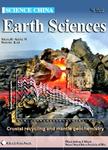Primary dolostone formation related to mantle-originated exhalative hydrothermal activities,Permian Yuejingou section,Santanghu area, Xinjiang,NW China
Primary dolostone formation related to mantle-originated exhalative hydrothermal activities,Permian Yuejingou section, Santanghu area,Xinjiang,NW China作者机构:State Key Laboratory of Continental DynamicsNorthwest UniversityDepartment of GeologyNorthwest UniversityXi'an 710069China Tu-Ha OilfieldCNPCHami 830002China Department of Geological Sciences and EngineeringMissouri University of Science and TechnologyRollaMissouri 65409USA College of Geological Science&EngineeringShandong University of Science and TechnologyQingdao 266510China
出 版 物:《Science China Earth Sciences》 (中国科学(地球科学英文版))
年 卷 期:2012年第55卷第2期
页 面:183-192页
核心收录:
学科分类:070801[理学-固体地球物理学] 081803[工学-地质工程] 07[理学] 08[工学] 0708[理学-地球物理学] 0818[工学-地质资源与地质工程] 0704[理学-天文学]
基 金:supported by National Natural Science Fundation of China (Grant No. 40802024) Sinopec Project "Study and Map Compilation for Structure, Lithofacies, and Paleogeography in Northwestern China (Grant No. YPH08103)" State Key Laboratory of Continental Dynamics (Grant No. BJ091358)
主 题:primary dolostone mantle-originated hydrothermal exhalative deposits intracontinental rift Permian Santanghu Area
摘 要:The Permian Lucaogou Formation is an important hydrocarbon source rock in the Junggar, Turpan, and Santanghu basins in Xinjiang, NW China. For the first time, dolostones associated with mantle-originated exhalative hydrothermal fluid flows are discovered in Yuejingou section in the Santanghu Basin area. They include dolomicrite, doloarenite, and a small amount of dolorudite, and are finely (0.05-0.15 cm thick) interlaminated with lime micrite and dolomicritic analcime laminites. Alkali feldspar and analcime grains are common in doloarenite and are interpreted as having been derived from analcime phonolites and peralkaline magmatic rocks. These magmatic fragments were brought up from subsurface by hydrothermal fluid flow and had experienced exhalative brecciation, transport, and deposition on the lake floor. The matrix consists dominantly of dolomite and ankerite smaller than 0.01 mm. The dolostones can be subdivided into four types on the basis of mineral composition and content. The detrital analcime and alkaline feldspar grains and tuff lithics are interpreted as intraclasts, which were deposited in an under-filled starved lake basin. The δ18OPDB values of dolostones are -5‰ to -21.1‰, and -11.9‰ on average; the 87Sr/86Sr ratios of dolostones are 0.70457 to 0.706194, and 0.705005 on average. These values, in combination with evidence of multi-episodes of peralkaline extrusion, suggest a mantle origin of the hydrothermal fluids, which may have promoted primary dolomite formation. The fluid from the upper mantle caused serpentinization of ultramafic rocks that intruded into the lower crust to obtain Mg2+ and Fe2+, and injected the ions into the lake water as the Mg and Fe sources for dolomite and ankerite. Hydro- thermal fluids associated with peralkaline magmatic rocks also provided Ca2+, Mg2+, Fe2+, and CO32-. Explosive breccias formed and dolostones were convoluted near the vent of hydrothermal fluid exhalation, whereas laminated dolostones formed farther away fr



